[深度應用]·Keras實現Self-Attention文字分類(機器如何讀懂人心)
[深度應用]·Keras實現Self-Attention文字分類(機器如何讀懂人心)
配合閱讀:
[深度概念]·Attention機制概念學習筆記
[TensorFlow深度學習深入]實戰三·分別使用DNN,CNN與RNN(LSTM)做文字情感分析
筆者在[深度概念]·Attention機制概念學習筆記博文中,講解了Attention機制的概念與技術細節,本篇內容配合講解,使用Keras實現Self-Attention文字分類,來讓大家更加深入理解Attention機制。
作為對比,可以訪問[TensorFlow深度學習深入]實戰三·分別使用DNN,CNN與RNN(LSTM)做文字情感分析,檢視不同網路區別與聯絡。
一、Self-Attention概念詳解
瞭解了模型大致原理,我們可以詳細的看一下究竟Self-Attention結構是怎樣的。其基本結構如下
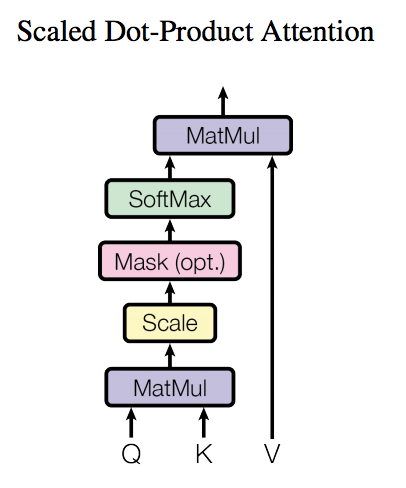
對於self-attention來講,Q(Query), K(Key), V(Value)三個矩陣均來自同一輸入,首先我們要計算Q與K之間的點乘,然後為了防止其結果過大,會除以一個尺度標度
,其中
為一個query和key向量的維度。再利用Softmax操作將其結果歸一化為概率分佈,然後再乘以矩陣V就得到權重求和的表示。該操作可以表示為
這裡可能比較抽象,我們來看一個具體的例子(圖片來源於https://jalammar.github.io/illustrated-transformer/,該部落格講解的極其清晰,強烈推薦),假如我們要翻譯一個片語Thinking Machines,其中Thinking的輸入的embedding vector用
表示,Machines的embedding vector用
表示。
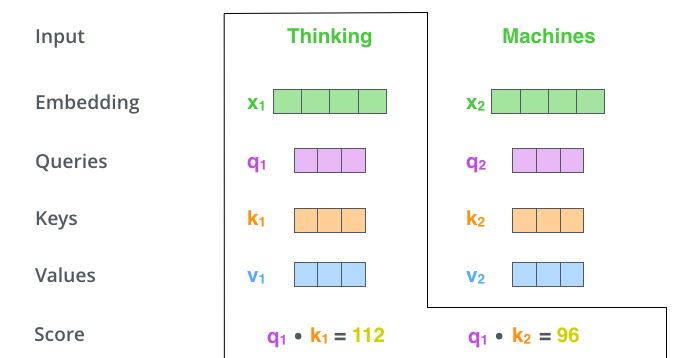
當我們處理Thinking這個詞時,我們需要計算句子中所有詞與它的Attention Score,這就像將當前詞作為搜尋的query,去和句子中所有詞(包含該詞本身)的key去匹配,看看相關度有多高。我們用
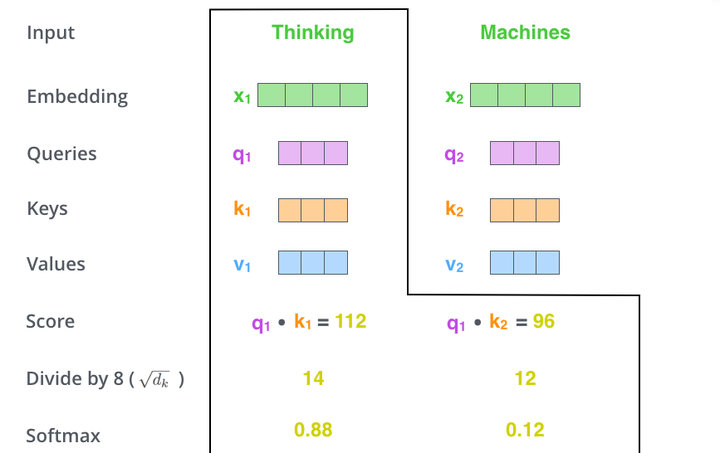
顯然,當前單詞與其自身的attention score一般最大,其他單詞根據與當前單詞重要程度有相應的score。然後我們在用這些attention score與value vector相乘,得到加權的向量。
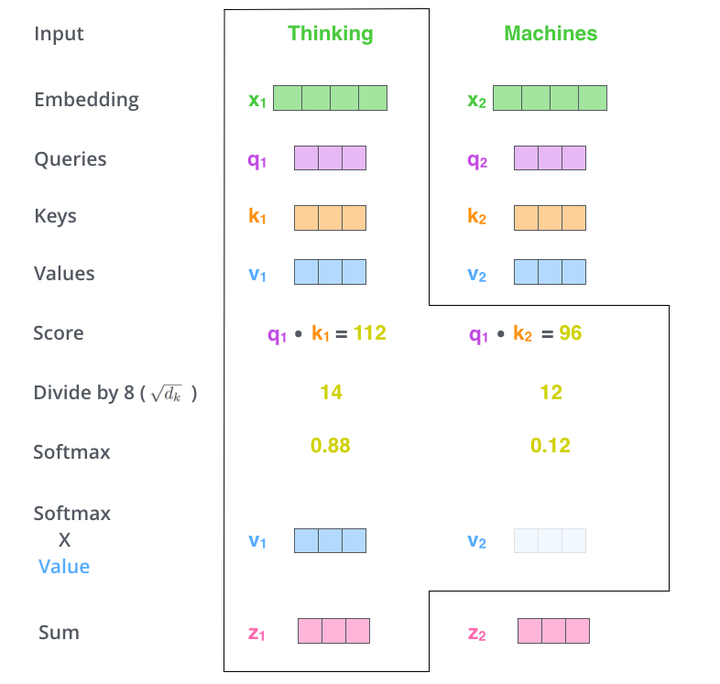
如果將輸入的所有向量合併為矩陣形式,則所有query, key, value向量也可以合併為矩陣形式表示
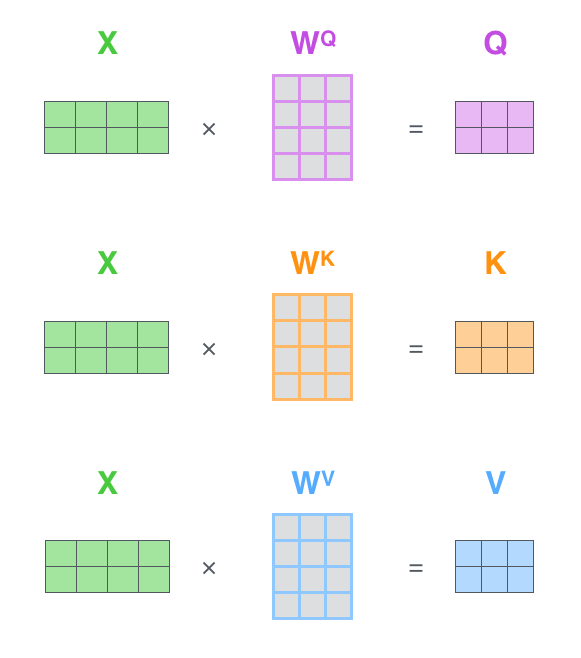
其中
是我們模型訓練過程學習到的合適的引數。上述操作即可簡化為矩陣形式
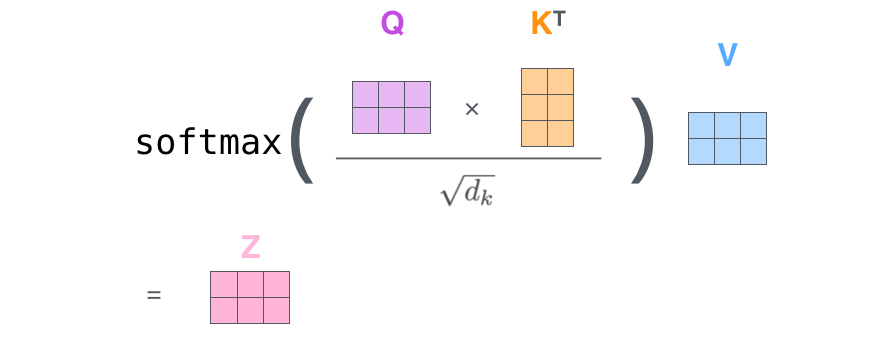
二、Self_Attention模型搭建
筆者使用Keras來實現對於Self_Attention模型的搭建,由於網路中間引數量比較多,這裡採用自定義網路層的方法構建Self_Attention,關於如何自定義Keras可以參看這裡:編寫你自己的 Keras 層
Keras實現自定義網路層。需要實現以下三個方法:(注意input_shape是包含batch_size項的)
build(input_shape): 這是你定義權重的地方。這個方法必須設self.built = True,可以通過呼叫super([Layer], self).build()完成。call(x): 這裡是編寫層的功能邏輯的地方。你只需要關注傳入call的第一個引數:輸入張量,除非你希望你的層支援masking。compute_output_shape(input_shape): 如果你的層更改了輸入張量的形狀,你應該在這裡定義形狀變化的邏輯,這讓Keras能夠自動推斷各層的形狀。
實現程式碼如下:
from keras.preprocessing import sequence
from keras.datasets import imdb
from matplotlib import pyplot as plt
import pandas as pd
from keras import backend as K
from keras.engine.topology import Layer
class Self_Attention(Layer):
def __init__(self, output_dim, **kwargs):
self.output_dim = output_dim
super(Self_Attention, self).__init__(**kwargs)
def build(self, input_shape):
# 為該層建立一個可訓練的權重
#inputs.shape = (batch_size, time_steps, seq_len)
self.kernel = self.add_weight(name='kernel',
shape=(3,input_shape[2], self.output_dim),
initializer='uniform',
trainable=True)
super(Self_Attention, self).build(input_shape) # 一定要在最後呼叫它
def call(self, x):
WQ = K.dot(x, self.kernel[0])
WK = K.dot(x, self.kernel[1])
WV = K.dot(x, self.kernel[2])
print("WQ.shape",WQ.shape)
print("K.permute_dimensions(WK, [0, 2, 1]).shape",K.permute_dimensions(WK, [0, 2, 1]).shape)
QK = K.batch_dot(WQ,K.permute_dimensions(WK, [0, 2, 1]))
QK = QK / (64**0.5)
QK = K.softmax(QK)
print("QK.shape",QK.shape)
V = K.batch_dot(QK,WV)
return V
def compute_output_shape(self, input_shape):
return (input_shape[0],input_shape[1],self.output_dim)
這裡可以對照一中的概念講解來理解程式碼
如果將輸入的所有向量合併為矩陣形式,則所有query, key, value向量也可以合併為矩陣形式表示

上述內容對應
WQ = K.dot(x, self.kernel[0])
WK = K.dot(x, self.kernel[1])
WV = K.dot(x, self.kernel[2])
其中
是我們模型訓練過程學習到的合適的引數。上述操作即可簡化為矩陣形式

上述內容對應(為什麼使用batch_dot呢?這是由於input_shape是包含batch_size項的)
QK = K.batch_dot(WQ,K.permute_dimensions(WK, [0, 2, 1]))
QK = QK / (64**0.5)
QK = K.softmax(QK)
print("QK.shape",QK.shape)
V = K.batch_dot(QK,WV)這裡 QK = QK / (64**0.5) 是除以一個歸一化係數,(64**0.5)是筆者自己定義的,其他文章可能會採用不同的方法。
三、訓練網路
專案完整程式碼如下,這裡使用的是Keras自帶的imdb影評資料集
#%%from keras.preprocessing import sequence
from keras.datasets import imdb
from matplotlib import pyplot as plt
import pandas as pd
from keras import backend as K
from keras.engine.topology import Layer
class Self_Attention(Layer):
def __init__(self, output_dim, **kwargs):
self.output_dim = output_dim
super(Self_Attention, self).__init__(**kwargs)
def build(self, input_shape):
# 為該層建立一個可訓練的權重
#inputs.shape = (batch_size, time_steps, seq_len)
self.kernel = self.add_weight(name='kernel',
shape=(3,input_shape[2], self.output_dim),
initializer='uniform',
trainable=True)
super(Self_Attention, self).build(input_shape) # 一定要在最後呼叫它
def call(self, x):
WQ = K.dot(x, self.kernel[0])
WK = K.dot(x, self.kernel[1])
WV = K.dot(x, self.kernel[2])
print("WQ.shape",WQ.shape)
print("K.permute_dimensions(WK, [0, 2, 1]).shape",K.permute_dimensions(WK, [0, 2, 1]).shape)
QK = K.batch_dot(WQ,K.permute_dimensions(WK, [0, 2, 1]))
QK = QK / (64**0.5)
QK = K.softmax(QK)
print("QK.shape",QK.shape)
V = K.batch_dot(QK,WV)
return V
def compute_output_shape(self, input_shape):
return (input_shape[0],input_shape[1],self.output_dim)
max_features = 20000
print('Loading data...')
(x_train, y_train), (x_test, y_test) = imdb.load_data(num_words=max_features)
#標籤轉換為獨熱碼
y_train, y_test = pd.get_dummies(y_train),pd.get_dummies(y_test)
print(len(x_train), 'train sequences')
print(len(x_test), 'test sequences')
#%%資料歸一化處理
maxlen = 64
print('Pad sequences (samples x time)')
x_train = sequence.pad_sequences(x_train, maxlen=maxlen)
x_test = sequence.pad_sequences(x_test, maxlen=maxlen)
print('x_train shape:', x_train.shape)
print('x_test shape:', x_test.shape)
#%%
batch_size = 32
from keras.models import Model
from keras.optimizers import SGD,Adam
from keras.layers import *
from Attention_keras import Attention,Position_Embedding
S_inputs = Input(shape=(64,), dtype='int32')
embeddings = Embedding(max_features, 128)(S_inputs)
O_seq = Self_Attention(128)(embeddings)
O_seq = GlobalAveragePooling1D()(O_seq)
O_seq = Dropout(0.5)(O_seq)
outputs = Dense(2, activation='softmax')(O_seq)
model = Model(inputs=S_inputs, outputs=outputs)
print(model.summary())
# try using different optimizers and different optimizer configs
opt = Adam(lr=0.0002,decay=0.00001)
loss = 'categorical_crossentropy'
model.compile(loss=loss,
optimizer=opt,
metrics=['accuracy'])
#%%
print('Train...')
h = model.fit(x_train, y_train,
batch_size=batch_size,
epochs=5,
validation_data=(x_test, y_test))
plt.plot(h.history["loss"],label="train_loss")
plt.plot(h.history["val_loss"],label="val_loss")
plt.plot(h.history["acc"],label="train_acc")
plt.plot(h.history["val_acc"],label="val_acc")
plt.legend()
plt.show()
#model.save("imdb.h5")
四、結果輸出

(TF_GPU) D:\Files\DATAs\prjs\python\tf_keras\transfromerdemo>C:/Files/APPs/RuanJian/Miniconda3/envs/TF_GPU/python.exe d:/Files/DATAs/prjs/python/tf_keras/transfromerdemo/train.1.py Using TensorFlow backend. Loading data... 25000 train sequences 25000 test sequences Pad sequences (samples x time) x_train shape: (25000, 64) x_test shape: (25000, 64) WQ.shape (?, 64, 128) K.permute_dimensions(WK, [0, 2, 1]).shape (?, 128, 64) QK.shape (?, 64, 64) _________________________________________________________________ Layer (type) Output Shape Param # ================================================================= input_1 (InputLayer) (None, 64) 0 _________________________________________________________________ embedding_1 (Embedding) (None, 64, 128) 2560000 _________________________________________________________________ self__attention_1 (Self_Atte (None, 64, 128) 49152 _________________________________________________________________ global_average_pooling1d_1 ( (None, 128) 0 _________________________________________________________________ dropout_1 (Dropout) (None, 128) 0 _________________________________________________________________ dense_1 (Dense) (None, 2) 258 ================================================================= Total params: 2,609,410 Trainable params: 2,609,410 Non-trainable params: 0 _________________________________________________________________ None Train... Train on 25000 samples, validate on 25000 samples Epoch 1/5 25000/25000 [==============================] - 17s 693us/step - loss: 0.5244 - acc: 0.7514 - val_loss: 0.3834 - val_acc: 0.8278 Epoch 2/5 25000/25000 [==============================] - 15s 615us/step - loss: 0.3257 - acc: 0.8593 - val_loss: 0.3689 - val_acc: 0.8368 Epoch 3/5 25000/25000 [==============================] - 15s 614us/step - loss: 0.2602 - acc: 0.8942 - val_loss: 0.3909 - val_acc: 0.8303 Epoch 4/5 25000/25000 [==============================] - 15s 618us/step - loss: 0.2078 - acc: 0.9179 - val_loss: 0.4482 - val_acc: 0.8215 Epoch 5/5 25000/25000 [==============================] - 15s 619us/step - loss: 0.1639 - acc: 0.9368 - val_loss: 0.5313 - val_acc: 0.8106
五、Reference
1.https://zhuanlan.zhihu.com/p/47282410
